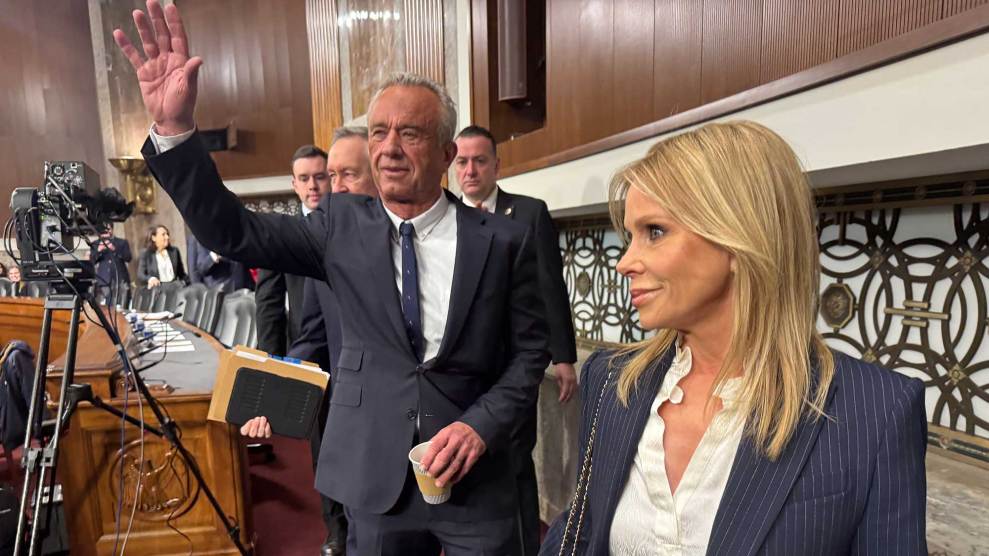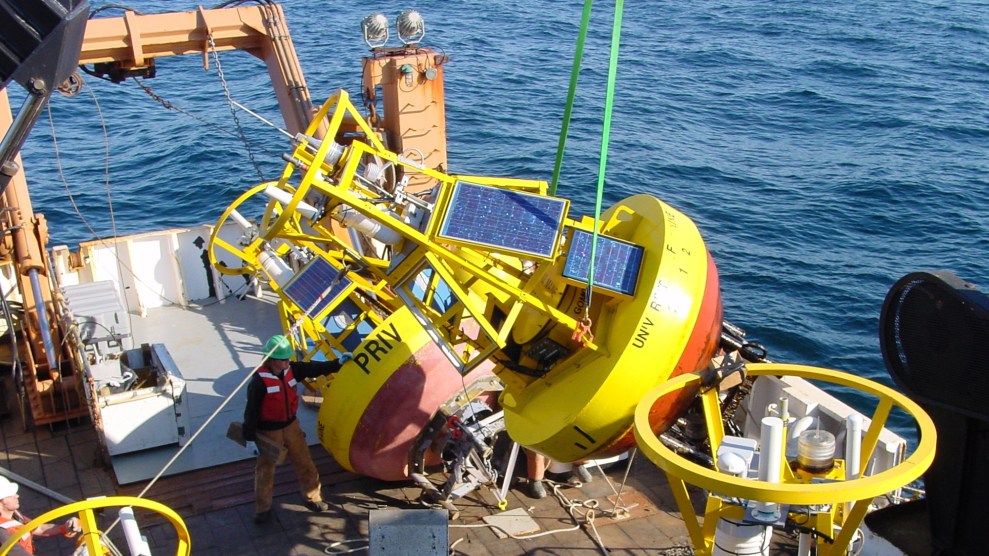Trudy Burgess stands beside an orange-and-black bus parked in downtown Invercargill, New Zealand, urging residents to think before they eat. As people pass the eye-catching vehicle on this October day, Burgess warns them of a potential danger they probably faced over breakfast: food from plants that have been genetically altered. “The reality is that 60 percent of all processed foods are at risk,” Burgess explains to a local reporter. “We want people to be more discerning when they are shopping.”
Burgess and other activists also want to keep genetically engineered (GE) foods off the market while the New Zealand government studies the health and environmental effects of taking genes from one species and inserting them into another. So far, more than 91,000 New Zealanders have signed a petition calling for a moratorium on genetically engineered foods imported from the United States. Throughout Europe and Asia, a growing number of scientists, elected officials, and activists have sounded the alarm over bioengineered agriculture. Japan, the largest importer of American crops, is now considering mandatory labeling of GE products. Some European nations have stopped buying U.S. corn in order to stop any gene-altered grain at their borders.
The mainstream media in the United States has mainly portrayed the widespread international concern as little more than a foreign backlash against the increasing Americanization of the planet. “Where it was once the deployment of American Pershing-2 missiles that caused alarm,” The New York Times declared last summer, “now it is McDonald’s, Coca-Cola, genetically modified American corn and American beef fattened with growth hormones that have Europe up in arms.”
In the past few months, however, the worldwide revolt over gene-altered foods has begun to take root in this country — sowing apprehension in the boardrooms of biotechnology giants like Monsanto and Novartis Seeds. In November, the industry launched a multimillion-dollar public relations blitz to counteract the growing chorus of opposition. The protests have “crossed the boundaries of reasonableness,” Edward Shonsey, chief executive of Novartis, told the Times, “and now it’s up to us to protect and defend biotechnology.”
But polishing the image of biotech foods won’t make them any easier to swallow — or any less risky. Research suggests that genetic engineering of food products could create unexpected new allergens or contaminate products in unanticipated ways, resulting in threats to public health. Critics of the rapid introduction of GE crops into the food supply point to one particularly alarming incident in which dozens of people were killed and 1,500 others afflicted by an excruciatingly painful disorder scientists suspect is linked to a bacterium engineered to produce the food supplement L-tryptophan. In addition, many scientists fear that bioengineered crops could spark widespread ecological damage, creating insecticide-resistant bugs and herbicide-resistant “superweeds” that would make kudzu and purple loosestrife look like so many summer dandelions.
The potential impacts on human health are the ones that have stirred the most consumer protest. Instead of thoroughly responding to such concerns, critics say, the Food and Drug Administration — the agency charged with safeguarding the food supply — has bowed to the influence of major biotech corporations — in particular, Monsanto, which has enjoyed an especially cozy revolving-door relationship with FDA regulators.
According to internal documents, the FDA ignored objections from several of its own top scientists when it ruled, in a landmark 1992 policy statement, that genetically engineered foods are similar to those produced by traditional plant breeding, and are hence “generally recognized as safe.” Despite mounting scientific concern, the Clinton administration still adheres to that policy, requiring nowhere near the intensity of testing that would apply to a food additive, such as an artificial sweetener — let alone a drug. In addition, the FDA requests only that firms conduct their own safety assessments of new products containing GE components. The FDA has received such self-assessments for each GE product it has approved so far, but “does not conduct a scientific review of the firm’s decision [to bring the product to market],” according to an agency spokesperson. It also allows the companies to place these foods on supermarket shelves without providing any information on the label to tell consumers what they’re getting.
Today an estimated 60 percent of all processed foods — from candy bars and tortilla chips to tofu dogs and infant formula — contain at least one genetically engineered component. This year, American farmers planted an estimated 60 million acres — an area the size of the United Kingdom — with genetically engineered crops, accounting for nearly half of all soybeans and a third of all corn in the United States. Without rigorous testing and accurate labeling, there is simply no way to predict what kinds of dangers such foods may pose, say critics of the FDA policy.
The current lack of regulation “is like playing Russian roulette with public health,” says Philip J. Regal, a biologist at the University of Minnesota who has published widely on the risks of GE foods. “We’ve had years and years of scientific discussion about this, and the conclusion is very clear,” he adds. “If it continues along this path, some of these foods are eventually going to hurt somebody.”
In a sense, humans have been genetically manipulating food for centuries. Traditional plant breeding could be called a form of genetic engineering: Farmers routinely select strains of crops for desirable characteristics such as higher yields, disease resistance, and more pleasing textures or colors. But there is one key difference: In traditional plant breeding, genes are mixed between apples and apples, so to speak — that is, between plants that are closely related, if not virtually identical, from a genetic standpoint. The protests over genetically engineered foods center instead on the potential hazards of “clipping” a gene sequence from the DNA of one plant or animal species (using specialized enzymes as the scissors), then inserting it into the DNA of another species.
Consider one way scientists create seeds for corn that carries a gene for toxicity to certain insects — a gene captured from the bacterium Bacillus thuringiensis, or Bt. Geneticists link the Bt gene to a DNA strand containing a “marker” gene for antibiotic resistance. This combined DNA fragment is then literally blasted into plant cells with a “gene gun,” and some of these target cells spawn plants that secrete the Bt toxin — and are able to kill the insects that would otherwise eat them. Farmers purchase the engineered seeds from these plants, typically at a high cost premium, on the assumption that they will need to spray less chemical pesticide on their crops.
The problem with such gene splicing, say some leading scientists, is that transferring genes between different plant species — or even between animals and plants — can change the characteristics of crops in unintended and perhaps dangerous ways. Even those who believe that many or even most bioengineered foods will ultimately be proven safe have serious concerns. Dr. Rebecca Goldburg, a biologist with the Environmental Defense Fund (EDF) who has followed the new science closely for more than a decade, cautions, “Companies are manipulating the food supply in ways never before possible. People need to know that some of these foods could turn out to be unhealthy to eat or harmful to the environment.”
Gene-altered crops may endanger human health in several ways. New crops could produce unexpected allergens, or chemicals that can interfere with enzymes or hormones in the body. (Disruption of hormones in a pregnant woman’s body can be profoundly damaging to her offspring.) One of the most disturbing prospects is that engineered proteins from living things that humans have never consumed will end up in supermarket foods, and that some could trigger heretofore unknown health effects.
Some of the earliest attempts at modified foods indicate just how risky genetic tampering can be. Seed company Pioneer Hi-Bred developed a soybean containing DNA from Brazil nuts that boosted levels of the amino acid methionine, making the beans more nutritious as animal feed. Many observers were quick to endorse the new bean. “Because brazil nuts and methionine are known to be safe,” the Washington Post declared in 1992, “the new soybean variety might not require formal FDA approval.” As it happens, the Post‘s optimism was unfounded. The company later realized that people allergic to Brazil nuts might also be allergic to the beans — some of which would have inevitably found their way into soy-based products for human consumption. In 1996, Pioneer withdrew the product.
Not every company has acted so quickly. Scientists are still questioning whether gene-altered bacteria used to make the dietary supplement L-tryptophan caused deadly consequences. L-tryptophan is an essential amino acid that occurs naturally in such foods as turkey and milk. It plays a crucial role in the production of the brain chemicals serotonin and melatonin, and consumers have used it as a dietary supplement to treat depression, sleep disorders, and a variety of other physical and psychological ailments. In the past, manufacturers produced it by extracting it from bacteria. But in the 1980s, a Japanese company, Showa Denko K.K., developed a method to boost production of the chemical: It inserted new genes into the bacteria, inducing them to make greater amounts of L-tryptophan.
In 1989, shortly after the product hit the shelves, more than 1,500 Americans became afflicted with a mysterious ailment dubbed Eosinophilia-Myalgia Syndrome, a debilitating disorder that can cause severe muscle pain, heart problems, memory defects, and paralysis. Thirty-seven people died during the outbreak. Nearly all the victims had been taking Showa Denko’s L-tryptophan, which was found to contain potent traces of toxic compounds. Scientific studies were unable to prove conclusively what generated the toxins. But scientists in the United States and Canada have published analyses indicating that the genetic engineering may have boosted the concentrations of L-tryptophan produced by the bacteria, causing molecules of the compound to bond, thus producing the toxins.
Beyond human health concerns, genetic engineering poses potential threats to the environment. One of the biotech industry’s goals is to develop crops that are resistant to herbicides. That, in turn, would enable farmers to saturate their fields with potent herbicides, killing all the weeds but allowing the crop to survive; for the seed makers, this could lead to greater demand for their own herbicides. Monsanto, in fact, has already developed corn and soybeans that are highly resistant to its commercially successful herbicide, Roundup. After 2002, the company plans to introduce “Roundup Ready” wheat. But there’s a catch: Many scientists fear that the wheat will hybridize with — and pass its herbicide tolerance to — a closely related weed called goat grass. The resulting hybrid could become what the EDF’s Goldburg calls a “superweed,” invulnerable even to an herbicide as powerful as Roundup.
Other genetically engineered crops might also cause unintended damage to ecosystems. Last year, scientists from Cornell University reported in the journal Nature that pollen from Bt-laced corn could escape from farm fields, settle on nearby milkweed plants, and kill the larvae of beneficial insects, such as monarch butterflies, that feed on milkweed. Though the biotech industry’s leading trade group dismissed the report, the Union of Concerned Scientists and four leading environmental groups called on the EPA to restrict the planting of Bt corn and study the product’s effects.
All of this — the threat to monarchs, the potentially allergenic Hi-Bred soybeans, the illness and death linked to tainted L- tryptophan — comes as no surprise to Dr. Richard Lacey. A professor of medical microbiology at the University of Leeds and an expert on food safety, Lacey predicted the malady that descended on Britain in the mid-1990s and came to be called “mad cow disease.” “Recombinant DNA technology is an inherently risky method for producing new foods,” insists Lacey. “Its risks are in large part due to the complexity and interdependency of the parts of a living system, including its DNA. Wedging foreign genetic material in an essentially random manner into an organism’s genome necessarily causes some degree of disruption, and the disruption could be multifaceted.”
The danger, adds Lacey, lies in how little we know. “It is impossible to predict what specific problems could result in the case of any particular genetically engineered organism,” he says.
Given the potential risks — and the warnings from respected scientists — how did genetically engineered crops find their way onto farms, and then into supermarkets, with such ease? A review of the federal policymaking process, supported by testimony and documents from a lawsuit against the FDA, suggests that the political influence of the biotech industry effectively silenced government regulators charged with safeguarding the public.
The hands-off approach to regulation began during the Bush administration, which was eager to foster a nascent biotech industry with the potential to generate corporate profits and foreign trade. On May 21, 1992, only days before the FDA issued its permissive policy on GE foods, a top administration official weighed in. James B. MacRae Jr., assistant administrator of the Office of Management and Budget, sent a memo to White House counsel C. Boyden Gray suggesting that the policy “should avoid emphasizing obligatory FDA review and oversight,” and instead allow the industry to regulate itself “with informal FDA consultation only if significant safety or nutritional concerns arise.” MacRae also suggested that the FDA policy “should state that newer techniques actually may produce safer foods.” (The budget bureaucrat’s sanguine prediction appeared, verbatim, in the final document.)
But the FDA did more than yield to political pressure — it also ignored the concerns of its own experts. According to internal memos and computer files uncovered during a lawsuit brought against the agency in 1998 by two public interest groups, the Alliance for Bio-Integrity and the International Center for Technology Assessment, some of the government’s own scientists disagreed with its developing policy.
In 1992, the year the policy was issued, Dr. Louis J. Pribyl of the FDA’s Microbiology Group warned in an internal memo of “a profound difference between the types of unexpected effects from traditional breeding and genetic engineering.” Dr. Linda Kahl, an FDA compliance officer, concurred that plant breeding and genetic engineering are different processes, adding that “according to the technical experts in the agency, they lead to different risks.”
In a letter written the previous October, James Maryanski, manager of the FDA’s biotechnology working group, acknowledged that some scientists felt strongly that more testing was needed. “As I know you are aware,” he wrote to Canadian counterparts working on a policy of their own, “there are a number of specific issues for which a scientific consensus does not exist currently, especially the need for specific toxicology tests.”
And that December, Dr. Mitchell J. Smith, head of the Department of Health and Human Service’s Biological and Organic Chemistry Section, drafted a memo to the FDA urging regulators not to repeat the errors of the past: “Just because the agency failed to evaluate ‘new substances’ introduced by conventional breeding,” Smith wrote, “gives it no reason to continue to do so now with new biotechnology.”
But when the FDA was confronted in court with evidence of such internal opposition, the agency responded by suggesting that the comments were only from low-level employees. “The FDA has not denied in court that their scientists made those statements,” says attorney Steven Druker, who directs the Iowa-based Alliance for Bio-Integrity. “They’re now claiming that those were the views of a handful of ‘low-level employees,’ which is a misrepresentation.”
Other testimony offered in the lawsuit indicates that some government experts had been questioning the safety of GE foods all along. Biologist Regal testified that while attending a 1988 conference in Maryland he spoke with several FDA scientists concerned about biotech crops. “I was shocked to learn the extent of uncertainty” over the safety of GE foods, he recalled. “Government scientist after scientist acknowledged there was no way to assure the safety of genetically engineered foods. Several expressed the idea that, in order to take this important step of progress, society was going to have to bear an unavoidable measure of risk.”
Some observers expected that the Clinton administration would adopt a harder line against genetically modified foods, especially since Vice President Al Gore had taken a keen interest in the subject well before the 1992 election. In the early 1980s, then-Senator Gore had chaired a congressional subcommittee that criticized the government for inadequately assessing the risks of biotech organisms; he had again criticized the biotech industry in a 1991 law journal article. But under Clinton, the FDA has stuck to its laissez-faire policy, and the administration itself has taken up biotech promotion with gusto, leaning heavily on foreign governments to accept genetically engineered foods created by U.S. biotech giants. In 1998, for instance, the administration threatened to withdraw from a proposed trade pact if New Zealand required labeling of gene-altered foods.
This heavy-handed approach has failed to quell growing public suspicion of biotech products, both at home and abroad. Last August two major Japanese breweries, the Kirin Brewery Company and Sapporo Breweries, announced that they would not use gene-altered corn in their beer, and the Gerber and H.J. Heinz baby-food makers have also rejected modified ingredients. Whole Foods Market, the nation’s largest natural foods chain, requires suppliers of its house brands to certify that their products contain no genetically modified substances, and requests the same of all other suppliers. And soybean exporter Archer Daniels Midland has instituted a two-tiered price system, offering farmers 18 cents extra per bushel of traditional soybeans because it is having trouble selling modified soybeans overseas.
Public outcry has forced Congress to consider regulation. After more than 500,000 people signed a petition demanding tougher controls for gene-altered foods, a bipartisan group of 20 representatives introduced legislation in November that would require labeling of genetically engineered products. A parallel Senate bill is in development at this writing.
For its part, the FDA says it is already doing enough to protect the public. “We do feel that the current regulatory scheme is adequate,” an FDA spokesperson told Mother Jones. That sentiment is echoed by Dr. Nega Beru, a consumer-safety officer in the agency’s regulatory policy branch. Asked how the FDA can maintain a policy that these foods are “generally recognized as safe” when a large number of well-credentialed scientists say they do not recognize them as such, Beru responded, “We’re not aware of any information that shows that these foods possess any unique health concerns, and we’re not aware that these foods are any different than foods produced by traditional methods.” In short, the philosophic underpinnings of the 1992 policy on GE foods still prevail.
Still, the FDA’s spokesperson said the agency is in “listening mode,” pointing to public meetings that it had planned for late 1999 in Washington, Chicago, and Oakland. The meetings, she said, were for “anyone who is interested to tell us about any new science or about ways we can better inform the public about these products.” Afterward, she added, the FDA would review the comments “over some unspecified period of time.”
Given its wait-and-see attitude — and its close ties to the industry — the FDA appears unlikely to use its authority to slow the biotech juggernaut without additional pressure from the public or Congress. “They’ve been holding hearings like this for 15 years,” says Regal. “They spend a lot of money holding meetings, listen and take lots of notes, maybe even invite a few scientists in to be the conscience of the republic. Then nothing changes.”
Additional MoJo Coverage
- WTO Hot Button: Genetically Modified Foods,br>(MoJo Wire, Nov. 24, 1999)
- A Seedy Business (MoJo Wire, April 7, 1998)
- Organic Engineering (May/June 1998)
- A Growing Concern (Jan/Feb 1997)
Other Resources on Genetically Modified Foods
- The Center for Food Safety
Tell the FDA and your Congressional representatives what you think with only a few keystrokes. (The page includes a form letter that you can send as is or personalized.) - Alliance for Bio-Integrity
Read original documents in which FDA scientists raised concerns over the 1992 policy. - The Food and Drug Administration’s Bioengineered Foods page
- The Campaign to Label Genetically Engineered Foods
- Center for Food Safety Home Page
- The Biodemocracy Campaign
- Greenpeace Genetic Engineering Page
















